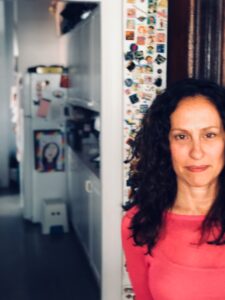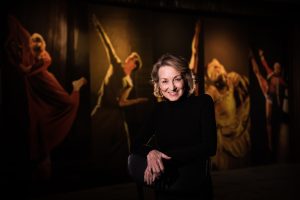PODCAST 171: Stefanie Nelson
 Release Date: 3.11.24
Release Date: 3.11.24
TO DOWNLOAD PODCAST OR LISTEN:
Finding Your Artistry Beyond Words with Stefanie Nelson
Episode 171: Show Notes
One of the beautiful things about dance is the ability to express yourself without words. You can just dance. Joining Erin on the podcast today is Stefanie Nelson, Founder and Director of Stefanie Nelson Dancegroup (SND), a contemporary dance company based in NYC. Stefanie also established Dance Italia, an international summer dance program in Lucca, Italy. Today, she shares what kickstarted her lifelong love of dance and the influence that Alice Teirstein had on her journey. She also offers insight into her college journey and what it takes to make it as an artist in New York City. Tuning in, you’ll learn how she transitioned from dancer to choreographer and how 9/11 ultimately led her to Italy. She details her time dancing and choreographing in Italy before returning to America and shares her vision for Dance Italia. To learn more about Stefanie’s career highlights, challenges, and the different projects and initiatives that keep her busy, be sure not to miss this episode of Movers & Shapers. Thanks for listening in!
Key Points From This Episode:
- How quitting piano led Stefanie to a lifelong love of dance.
- Alice Teirstein and what led her to become a dancer.
- What it means to “make it work” as an artist in New York City.
- How Stefanie eventually transitioned into creating her own work as a choreographer.
- Running away to Italy after 9/11 and how it played out.
- Highlights from her time dancing and choreographing in Italy.
- Returning to America while keeping the connections to Italy with Dance Italia.
- Details about the Dance Italia festival and the vision behind it.
- How the organization and planning for Dance Italia have changed over the years.
- The different projects and initiatives that Stefanie is busy with.
- Insight into her upcoming work in 2025 and beyond.
- Highlights, challenges, and other obstacles from Stefanie’s career journey.
- Her hopes, aspirations, and dreams for the future.
“There’s something very beautiful about being able to express yourself without having to articulate words, ideas, thoughts, and sentences in a linear way.” — Stefanie Nelson
ABOUT STEFANIE
Stefanie Nelson is the Founder and Director of Stefanie Nelson Dancegroup (SND), a contemporary performance group based in NYC; DANCE ITALIA, an international summer dance festival in Lucca, Italy; and Motore 592, a bold, new, center for contemporary movement practices in Lucca, IT.
Founded in 2000, SND is a New York City-based contemporary performance ensemble producing original work in close creative partnership with performers, visual artists and composers. The company’s work is driven by a distinctly conceptual impetus and characterized by a visceral and strikingly visual approach. For over two decades, SND has evolved from an artistic endeavor into a public service-driven and education-focused organization, invested in using dance as a tool for healing, community building, and empowerment. Mission-driven community service programs include: EVERYONE DANCE: working with NYC’s disabled population in collaboration with AHRC NYC, a disability service organization, since 2014; The MOVING MEMORY PROJECT: a festival series of professional art performances and movement classes for seniors with dementia, since 2019; DANCE ITALIA, summer dance festival for pre-professional contemporary dancers since 2011, and CREATIVE MOVEMENT classes for children ages 5-7 at Hunter College Elementary School, since 2009.
Beyond community programming, SND presents work at the foremost contemporary performance venues including Lincoln Center Out-of-Doors, Jacob’s Pillow, LaMama Moves!; internationally in Canada, Mexico and throughout Italy at festivals such as Fabbrica Europa, Florence Winter Dance Festival, & Festival de la Ciudad. Residencies include the Baryshnikov Arts Center, Bessie Schoenberg Residency at The Yard, Indiana University, SUNY Purchase (NY), FLYING TIGER (NY Store Opening).
Entering the dance field as a performer, notably as a soloist with Anna Sokolow’s Player’s Project, Nelson is an accomplished teacher having taught at studios and educational institutions worldwide. The New York Foundation for the Arts (NYFA) identified her as an ‘Emerging Leader’, providing a yearlong mentorship. She’s served as a Choreography panelist for NYFA’s prestigious Artists’ Fellowship awards as well as for the Joyce Theater and local NYC dance festivals. Recent company support includes funding from the National Endowment of the Arts, the NYC Department of Cultural Affairs, the New York State Council on the Arts, and the West Harlem Development Corporation. Independent choreographic projects include collaborations with fashion designer Terrence Zhou / Bad Binch TONGTONG’s New York Fashion Week SS23 debut and SS24 show, Plan-B, a feature film starring Diane Keaton, & the NYC store opening of Flying Tiger.
Connect with Stefanie Nelson
sndancegroup.org
danceitalia.com
motore592.com
Links Mentioned in Today’s Episode:
Podcast produced by: The Moving Architects
Interviewer: Erin Carlisle Norton


 Release Date: 3.11.24
Release Date: 3.11.24

 TO DOWNLOAD PODCAST OR LISTEN:
TO DOWNLOAD PODCAST OR LISTEN:
 TO DOWNLOAD PODCAST OR LISTEN:
TO DOWNLOAD PODCAST OR LISTEN:
 TO DOWNLOAD PODCAST OR LISTEN:
TO DOWNLOAD PODCAST OR LISTEN:







